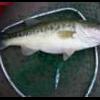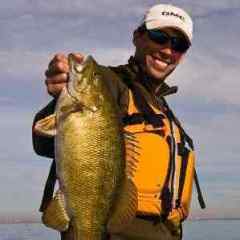(I should preface by saying, yeah fellows I'm still on the map)
---------------------------------------------------------------------------
Central Florida is currently in the early post-spawn period, which is to say, the boys to the north have a lot to look forward to.
Post-spawn-&-Buzzbaits are like Bread-&-Butter:
..............................................................................................BUZZBAITS
For sheer numbers of bass, Twitchbaits & Poppers probably lead the topwater division. With regard to trophy bass however,
the Buzzbait is the clear winner. The Lunker Lure Buzzbait introduced in 1976 is touted as the first buzzbait, but wasn't even close.
The earliest buzzbait was the "Arbogast Hawaiian Wiggler", a lure-class originally called "buzzspins" that employed a delivery known as "skittering". When I was a kid in the 1950s, I fished the Hawaiian Wiggler and now wish I had saved a few of those vintage spinners. It was an elongate lure
with a forward prop and trailing rubber skirt. The main difference between vintage buzzers and modern buzzers is the spinner-shaft.
In the early versions, the spinner was mounted on a straight shaft but today the prop is normally mounted on a safety-pin shaft (over-spinner). Hawaiian culture was popular during that era, when Arthur Godfrey and ukuleles were in vogue (some of the old timers may recall).
The word "Wiggler" alluded to a hula dancer and in 1938 Fred Arbogast patented the wiggler's "Hawaiian Skirt".
Although the word "Hawaiian" got lost in the shuffle, the word "Skirt" persists to this day. During that same era, Al Foss produced two buzzbaits using bucktail skirts instead of rubber skirts, namely: Al Foss Dixie Wiggler and Al Foss Shimmy Wiggler.
Based on historic recordkeeping, buzzspins were trophy killers right from the get-go. In this case, the term "killer" is not a hyperbole,
as that was the era of "catch & keep". In fact, if you were caught releasing a bass, you'd probably be chased by men in white coats.
The statistics below are based on bass citations awarded by Field and Stream magazine between 1943 to 1953. The stats represent
the 50 heaviest certified largemouth bass taken from the Southern Division during that 10-year period. The "Southern Division"
extended from Lake Bedford, Tennessee, southward to the southern border of the United States:
LURE................HARVEST
Plugs................37,,,,,(74%)
Buzzspins.........6,,,,,,,(12%)
Live Minnows,,,,6,,,,,.,(12%)
Spoons..............1.......(2%)
When I was a youngster there were only 3 basic classes of bass lures: Spinners, Spoons & Plugs. During that time,
Plugs and Live Bait clearly dominated the field. The term "plug" however included any wooden or hard plastic lure
which ran the gamut from topwater Jitterbugs to deep-diving Bombers. Then during the 1970s, I heard Rick Clunn
refer to his cedar Poe plug as a "crankbait" (say what?). All my life the term "bait" alluded to minnows, worms, crickets
and hellgrammites. From that day forth, natural bait and artificial lures would all be lumped together as "BAIT" (and so it goes).
In an age dominated by plugs and bait, it's not surprising that plugs had an obscene lead. The real surprise however
is the powerful showing by buzzspins (buzzbaits). remarkably they ran abreast with live bait! Some things never change.
Fast-Forward to the Present
Incepted by Don Wirth, the "Day On The Lake" series is comprised of leading bass pros who fish 7 hours on a small waterbody
they've never fished before. To qualify as a lunker, a largemouth bass must weigh at least 6 pounds and a smallmouth must weigh
at least 4 pounds. Throughout the 13-year period from 1998 to 2011, pro anglers boated 44 eligible bass consisting of 38 largemouth bass
and 6 smallmouth bass. Among the 38 largemouth bass entries, only 3 weighed over 10 pounds, while the largest during that 13-yr stint
went 11-lb 14-oz. (Once again, we see that stubborn "12-lb ceiling").
Standalone trailers yielded 3 out of the 38 largemouth lunkers, which I generically lumped together as "Creatures"
(1 flappin hog, 1 chickenfoot worm, 1 plastic craw). Unfortunately the trailer used in the "Jig & Trailer" category was rarely specified:
LURE..................HARVEST
Plugs..................12.....(32%)
Jigs & Trailers,,,,,10,,,,(26%)
Buzzbaits,,,,,,,,,,,,,5,,,,,,(13%)
Jerkbaits,,,,,,,,,,,,,,4,,,,,,(10.5%)
Tubes.................,4......(10.5%)
Creatures..........,.3,,,,,,(8%)
Swimbaits...........0......(0%)
Worms,,,,,,,,,,,,,,,,0,,,,,,(0%)
Senkos,,,,,,,,,,,,,,,0,,,,,,(0%)
Spinnerbaits,,,,,,,0,,,,,,(0%)
The breakdown reveals a few surprises, but bear two facts in mind:
>>> The pros were fishing unknown waters so search lures were popular.
>>> The results do not echo lure productivity, but pertain only to trophy production
Back on topic: "Buzzbaits" snatched third-place as a lunker producer, not unlike their historic performance during the 1940s.
Ironically, a 'Buzzbait' is nothing more than a topwater spinnerbait, yet 'Spinnerbaits' drew a blank.
If I may, I'd like to touch on buzzbait features, modifications and delivery in a subsequent post.
Roger



